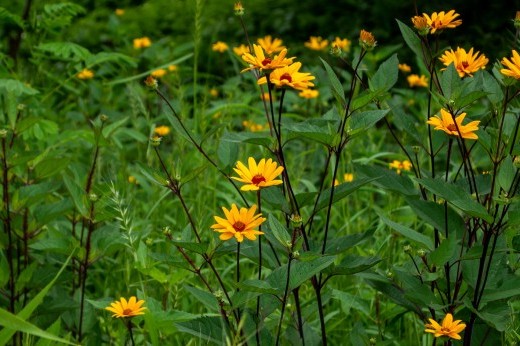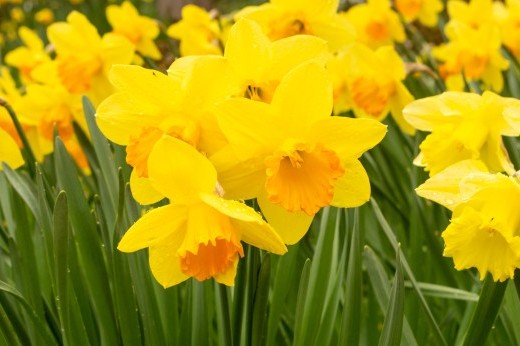Ask a Gardener is a seasonal gardening advice column written by Rock Garden gardener Laura Powell.
Can I plant perennials in the fall?
Louisa, Brooklyn, NY
Dear Louisa,
Yes! Fall is a great time to plant perennials, or plants that live for several years or more. For some plants, it’s even better than planting in the spring.
Transplanting is to plants as moving homes is to humans: It’s inherently stressful. You wouldn’t want to combine it with more stress, but that’s exactly what we do when we plant in the spring. After spring comes summer—which, with high temperatures and low rainfall, is often a stressful time for plants.
Planting in the fall offers these benefits:
- Less stress on plants. Fall planting allows perennials to establish their root systems before winter. With less demand on their energy for foliage growth or flower production, they can focus on root growth and be better prepared to thrive in the spring.
- Less need for watering. Fall often brings more consistent rainfall, reducing the need for frequent watering. The cooler temperatures also lead to less evaporation, helping the soil retain moisture.
- Less competition. In the fall, many annuals and weeds are reaching the end of their life cycle, reducing competition for moisture, nutrients, and space in the garden.
During winter, the plant will go dormant, so you don’t need to worry about caring for it. By the time summer arrives, the plant will be well-established and require less supplemental watering.
In addition to transplanting, you can also plant perennials in the fall by sowing seeds directly in the ground. Some seeds prefer to be sown in the fall as they require a cold period before they germinate—they will be dormant in the winter and then sprout in the spring. You may want to leave a plant stake or label so you don’t mistake the spring seedlings for weeds.
Keep in mind that while fall planting is beneficial for most perennials, there are exceptions. A good rule of thumb: If winter is a stressful time for your plant (often the case for evergreens, which are not dormant in the winter), you’ll want to consider spring planting. If your plant is dormant in the winter and the summer is most stressful (most herbaceous perennials), fall planting is often ideal.
Whether sowing directly by seed or transplanting, it’s a good idea to research the specific needs of the plants you want to add to your garden. If you can’t find information regarding planting time in your research, think about which season is most stressful for your plant.
Finally, consider your local climate to ensure your perennials have enough time to establish themselves before winter arrives. Try to plant at least a month before the average date of the first fall frost.
I’ve heard that fall is a good time to divide perennials. How would I do that?
Keisha, Maplewood, NJ
Dear Keisha,
Fall is indeed a good time to divide perennials.
Dividing is exactly what it sounds like: You divide a larger plant into smaller pieces. Gardeners divide plants because it stimulates new growth and often leads to more vigorous blooming, and it’s an easy and affordable way to increase the number of plants in your garden.
Ideal candidates for division include plants that have grown too large for their current space, plants that have reduced flowering, or perennials that are browning at the center of their crowns.
Once you’ve decided which plants to divide, follow these steps:
- Water the plants a day in advance if the soil is dry.
- Assemble your tools. You’ll need a tool to dig up the plant and a tool to cut the roots. If you have a sharp garden spade, you can use that for both tasks. Alternatively, you can use a shovel or spade to dig up the plant, and pruners or a knife to cut the roots.
- Dig up the plant. Carefully dig up the entire perennial clump and lift it out of the ground.
- Using your spade, knife, or pruners, divide the plant into smaller sections. Make sure you have both roots and foliage on each section.
- Replant each individual section separately in new locations. Plant at the same depth the plant was planted at previously.
- Water your newly planted divisions thoroughly. Add a layer of mulch around your new plantings to conserve water and regulate soil temperature.
- Water as you would any newly planted plant. You can gradually water it less frequently as it develops a deeper and stronger root system and becomes established in your garden.
If you don’t have enough room for all your divisions, sharing extra plants is a great way to connect with your friends, family, and neighbors. As our gardens grow, so do opportunities to build community.
What should I be doing in my garden in the fall?
Ayumi, Brooklyn, NY
Dear Ayumi,
Your fall tasks are going to depend on what’s growing in your garden. Do you have perennials? Annuals? Vegetables? Woody plants?
In addition to what is growing, your tasks will be determined by the “why” of your garden. Do you garden to support insect and bird populations? Then you may want to leave spent perennials standing, though some fall gardening checklists will advise cutting back. Do you grow food? Then you might be thinking about crop rotation and cover crop selection, and storing and preserving your harvest.
Here are some key fall gardening tasks, and you can pick out the ones that apply:
- Prune dead or diseased branches from trees and shrubs.
- Harvest any remaining vegetables, fruits, or herbs from your garden before the first freeze.
- Plant cool season crops like lettuce and radishes.
- Divide and transplant perennials. (More on this below!)
- Transplant deciduous trees and shrubs.
- Apply a layer of mulch to insulate the soil and protect plants from freezing temperatures.
- If tidiness is a factor, remove and compost spent annuals and vegetables. (If you'd like to add more organic matter to your soil, you can leave them in place to decompose.)
- Continue to add compost to your organic pile.
- Protect cold-sensitive plants. For plants that are borderline hardy in your climate, consider protection such as burlap, frost cloth, or even a layer of straw to shield them from harsh winter conditions.
- Plant spring-blooming bulbs.
- Plant garlic.
- If you have a vegetable garden, consider adding a cover crop (like oats or oilseed radish) to improve soil fertility and reduce erosion during the winter months.
- Water your garden if it doesn’t rain.
- Remove fallen leaves if necessary (e.g., if they’re on paved surfaces, or covering a plant). If not, consider leaving them in place.
The main tasks this season are the same as in all other seasons: caring and paying attention.
The art of gardening is the art of paying attention. If you pay attention to your garden, you will see what needs to be done. There’s so much to love about this season, from the changing leaf colors to late-season blooms and attractive seed heads.
Which brings me to the last item on our fall gardening checklist:
- Enjoy your garden.
Got a question for Laura? Submit questions for our winter installment of Ask a Gardener using the form below.



